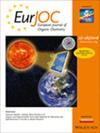蜘蛛表皮蜡重要成分长链二甲基烷基甲醚的合成
IF 2.7
3区 化学
Q2 CHEMISTRY, ORGANIC
引用次数: 0
摘要
长链甲基支链烷基甲基醚是许多蜘蛛角质层的重要成分,调节水分平衡和传递物种识别中使用的化学信号。这类化合物,或在昆虫中发现的相关碳氢化合物的合成,通常是耗时且效率不高的,主要是由于所涉及的长烷基链。本文对合成此类化合物的新策略进行了评价。首先研究了根岸sp2-sp3偶联反应,即使是很长的烷基链,产率也达到50-70%。然而,这种方法需要合成碘化乙烯,增加了额外的步骤。虽然甲基分支在这些合成中较早产生,但较晚的引入策略被证明是更有利的。为了促进这一点,通过在醛上添加炔基阴离子来实现链结构,从而产生内部丙炔醇,作为亲核甲基化的底物。铁催化甲基格氏加成生成甲基烯丙醇,随后通过氢化和醇去功能化转化为目标化合物。虽然这种方法对于中链长度的化合物是成功的,但对于很长的化合物就失败了。相反,丙炔甲酰基的甲基亲核加成形成烯,然后加氢,产率高,目标醚干净。本文章由计算机程序翻译,如有差异,请以英文原文为准。

Synthesis of Long‐Chain Dimethylalkyl Methyl Ethers, Important Components of the Epicuticular Wax of Spiders
Long‐chain methyl‐branched alkyl methyl ethers are essential constituents of the cuticle of many spiders, regulating water balance and transporting chemical signals used in species recognition. The synthesis of such compounds, or related hydrocarbons found in insects, is usually time‐consuming and not very efficient, mainly due to the long alkyl chains involved. Herein, new strategies for synthesizing such compounds are evaluated. Negishi sp2–sp3 coupling reactions are first investigated and proceed with yields of 50–70%, even with very long alkyl chains. However, such approaches require the synthesis of vinyl iodides, adding additional steps. While the methyl branches are created early in these syntheses, a late introduction strategy proves more favorable. To facilitate this, chain construction is achieved through the addition of an alkynyl anion to aldehydes, resulting in internal propargyl alcohols that serve as substrates for nucleophilic methylation. Iron‐catalyzed methyl Grignard addition yields methylallyl alcohols, which are subsequently converted into the target compounds through hydrogenation and alcohol defunctionalization. Although this approach is successful for compounds with medium chain length, it fails for very long compounds. Instead, allene formation by nucleophilic addition of the methyl group to propargyl mesylates, followed by hydrogenation, gives good yields and clean target ethers.
求助全文
通过发布文献求助,成功后即可免费获取论文全文。
去求助
来源期刊
CiteScore
5.40
自引率
3.60%
发文量
752
审稿时长
1 months
期刊介绍:
The European Journal of Organic Chemistry (2019 ISI Impact Factor 2.889) publishes Full Papers, Communications, and Minireviews from the entire spectrum of synthetic organic, bioorganic and physical-organic chemistry. It is published on behalf of Chemistry Europe, an association of 16 European chemical societies.
The following journals have been merged to form two leading journals, the European Journal of Organic Chemistry and the European Journal of Inorganic Chemistry:
Liebigs Annalen
Bulletin des Sociétés Chimiques Belges
Bulletin de la Société Chimique de France
Gazzetta Chimica Italiana
Recueil des Travaux Chimiques des Pays-Bas
Anales de Química
Chimika Chronika
Revista Portuguesa de Química
ACH—Models in Chemistry
Polish Journal of Chemistry.

 求助内容:
求助内容: 应助结果提醒方式:
应助结果提醒方式:


